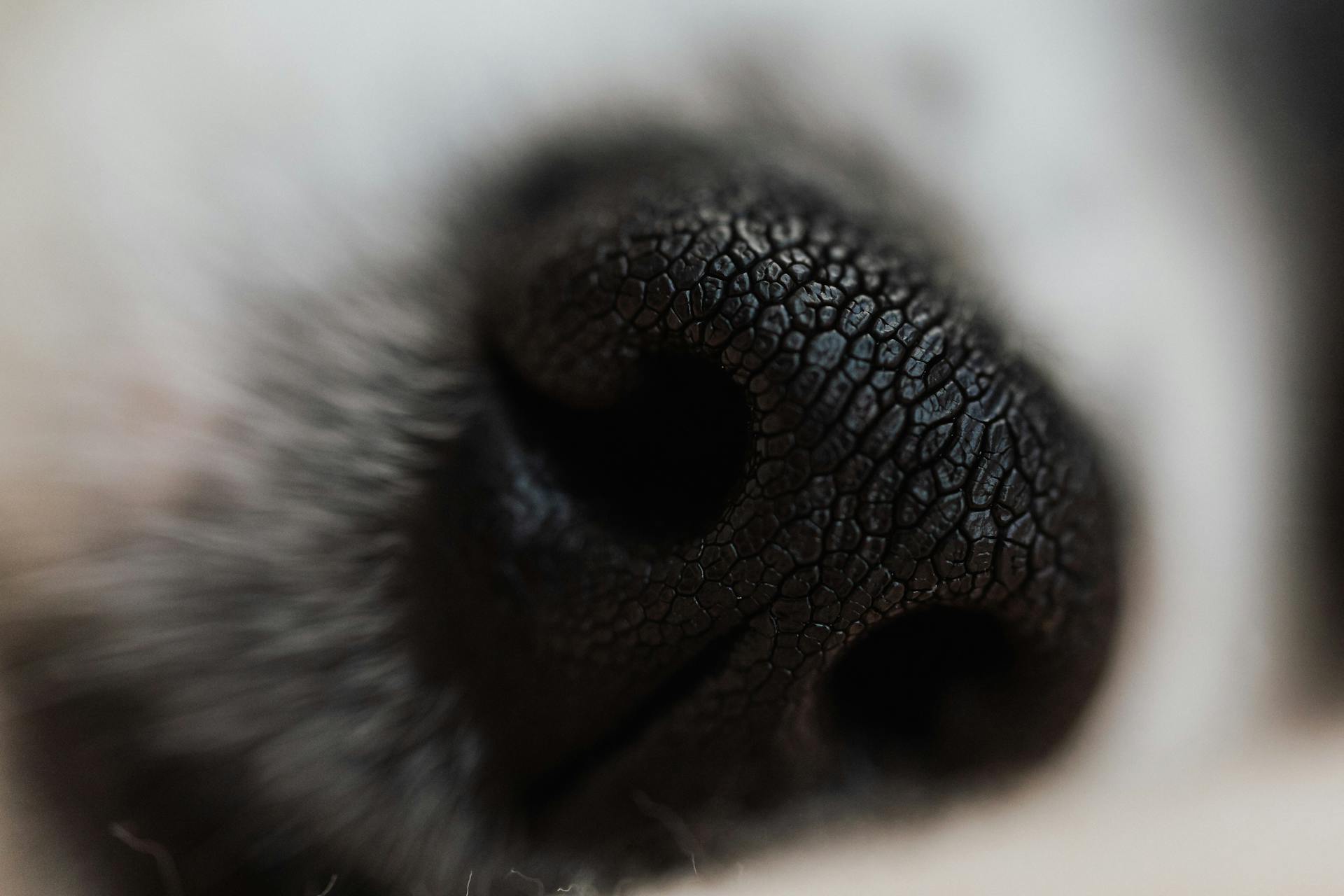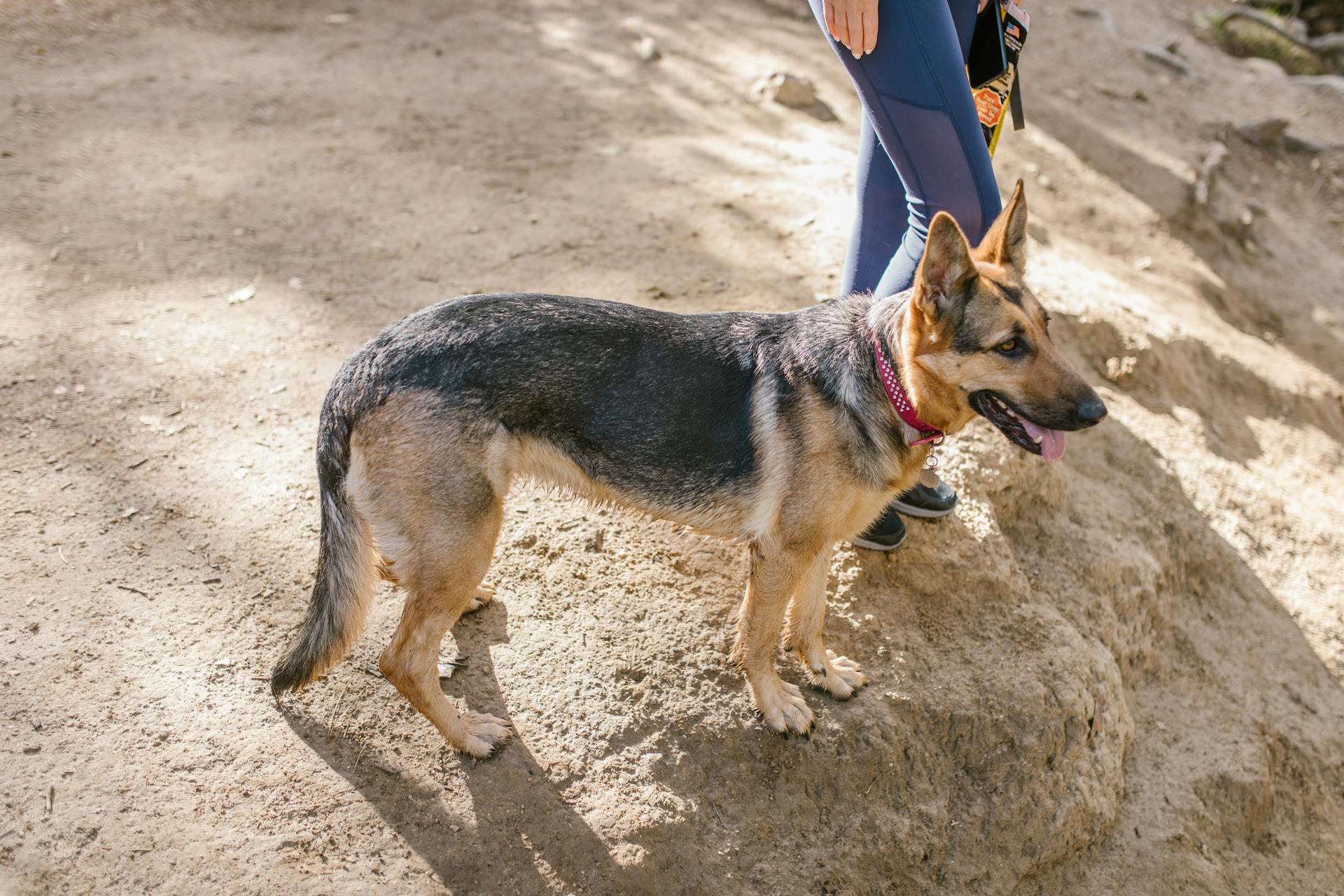
Pyoderma in German Shepherds can be a frustrating condition to deal with, but understanding the basics can help you take the first steps towards healing.
Pyoderma is a skin infection that affects German Shepherds, causing redness, itching, and hair loss.
It's a bacterial infection, typically caused by Staphylococcus pseudintermedius, which thrives in warm, moist environments, making it a common issue in dogs with skin folds.
A German Shepherd's coat can be a significant factor in the development of pyoderma, as excessive grooming can lead to skin irritation and create an ideal environment for bacteria to grow.
Common symptoms of pyoderma in German Shepherds include red, inflamed skin, pustules, and a strong, unpleasant odor.
For your interest: Bacterial Pyoderma Hypothyroidism in Dogs Skin Problems
What is Pyoderma?
Pyoderma is a bacterial skin infection that affects many breeds, including German Shepherds. It's a common issue that can cause a range of symptoms from mild irritation to severe lesions.
The infection is typically caused by Staphylococcus intermedius, a type of bacteria that's commonly found on the skin of dogs. This bacteria can cause a range of problems, from minor skin issues to life-threatening conditions.
Intriguing read: Skin Disorders in Dogs Hair Loss
Pyoderma can manifest in different forms, including follicular pyoderma, which affects the hair follicles, and intertrigo pyoderma, which occurs in skin folds. The symptoms can vary depending on the type and severity of the infection.
German Shepherds are particularly prone to pyoderma due to their thick double coat, which can trap moisture and create an ideal environment for bacteria to grow. Regular grooming and bathing can help prevent pyoderma in German Shepherds.
For more insights, see: Lip Fold Pyoderma in German Shepherds
Diagnosis and Treatment
A diagnosis of pyoderma in German Shepherds is often based on the dog's clinical signs and medical history.
Additional tests, such as blood tests to determine if your pet has an endocrine disease, skin cytology, skin culture and antibiotic sensitivity tests, and fungal cultures may be performed.
Topical antimicrobial therapy can be effective for localized or less severe pyoderma, and may be used alone for the first two weeks before adding oral antibiotics.
A culture and susceptibility test will determine the type of Staphylococcus species causing the pyoderma and the best antibiotic to use.
Practicing good hygiene, such as frequent hand washing, especially for those in close contact with the dog, can help prevent the transfer of bacteria and bacterial infection.
What Causes in Dogs?
Pyoderma in dogs can be caused by a bacterial skin infection that occurs when the skin's surface has been broken.
Chronic exposure to moisture can also lead to pyoderma, especially in skin folds like facial folds, lip folds, and groin or armpits.
Certain breeds are more prone to pyoderma, including Spaniels with lip fold pyoderma and Pekingese, Pugs, Boxer Dogs, and Bulldogs with facial fold pyoderma.
Skin folds allow the surface of the two adjacent areas to lie in close contact, creating a warm, humid environment that fosters bacterial growth.
This is why pyoderma often develops between the mammary glands in females that have had multiple litters of pups and in obese dogs where adjacent skin folds upon itself.
Puppies often develop puppy pyoderma in thin-haired areas such as the groin and underarms.
Fleas, ticks, yeast, or fungal skin infections, thyroid disease or hormonal imbalances, and some medications can increase the risk of pyoderma in dogs.
Related reading: My Dog Has a Lump on His Lip
How Is Diagnosed?
Diagnosis is a crucial step in treating pyoderma. A diagnosis of pyoderma is often based on a pet's clinical signs and medical history.
Clinical signs and medical history are the foundation of a pyoderma diagnosis. Additional tests may be performed to confirm the diagnosis and determine the underlying cause.
These tests can include blood tests to check for endocrine diseases, skin cytology to examine skin scrapings or tape preps under a microscope, skin culture and antibiotic sensitivity tests, and fungal cultures.
Skin cytology is a helpful tool in diagnosing pyoderma. It involves looking at a skin swab or tape prep under a microscope to check for signs of infection or inflammation.
A culture and susceptibility test can also be performed to determine the type of bacteria causing the pyoderma and what antibiotic will best treat it.
Here are some common findings on skin scraping/impression smear:
It's essential to note that a diagnosis of pyoderma may involve ruling out other conditions that could be causing similar symptoms. By narrowing down the differential diagnoses, veterinarians can develop an effective treatment plan for their patients.
Choosing an Antibiotic
You'll want to consider starting with topical antimicrobial therapy for the first two weeks, especially if Junior's pyoderma is localized or not too severe. Topical antimicrobial options include chlorhexidine-based shampoos for weekly baths and chlorhexidine spray or mousses for daily use on affected skin areas.
A culture and susceptibility test will determine the type of Staphylococcus species causing Junior's pyoderma and what antibiotic will best treat it. This test is crucial in choosing the right antibiotic.
Topical antimicrobial therapy alone may be enough to treat some cases of pyoderma, but in more severe cases, oral antibiotics may be necessary. Oral antibiotic options will depend on the results of the culture and susceptibility test.
Practicing good hygiene with frequent hand washing, especially for those in close contact with Junior, can help prevent the transfer of bacteria and infection.
Clinical Management
Clinical management of pyoderma in German Shepherds requires careful consideration of the underlying cause and severity of the condition.
In cases where pyoderma is severe or accompanied by significant pruritus, antimicrobial therapy is often necessary. This can include both topical and oral treatments.
Topical antimicrobial options such as chlorhexidine-based shampoos and sprays can be effective for localized or less severe cases, and may be used alone for the first two weeks before adding oral antibiotics.
Physical Examination
During a physical examination, your veterinarian will assess your dog's overall health and look for signs of pyoderma. They may use a Body Condition Score (BCS) to evaluate your dog's weight and body condition.
The BCS is scored from 1 to 9, with 1 being underweight and 9 being obese. In Junior's case, his BCS was 7/9.
Your veterinarian will also examine your dog's skin for signs of pyoderma, such as papules or pustules, circular crusts, dry or flaky patches of skin, hair loss, and itching.
Here are some common physical examination findings associated with pyoderma:
- Erythema (redness) in the inguinal region
- Pustules, papules, and yellowish crusts on the skin
- Epidermal collarettes on the skin with mild alopecia (hair loss)
- Mild interdigital erythema localized to all four feet
These findings can help your veterinarian diagnose superficial pyoderma and narrow down the possible underlying causes of your dog's skin condition.
Clinical Management
When treating skin conditions like pyoderma in pets, it's essential to start with the right treatment plan.
You may want to consider starting with topical antimicrobial therapy, such as chlorhexidine-based shampoos for weekly baths and chlorhexidine spray or mousses for daily use on affected skin areas.
If the condition is severe, you may also need to add oral antibiotic therapy, but it's best to start with topical therapy alone for the first two weeks to see if the condition responds.
If the condition doesn't improve with treatment, it's crucial to reevaluate the treatment plan and consider alternative options.
A good approach is to keep a close eye on the pet's response to treatment and adjust the plan as needed.
Here are some common signs of pyoderma that you should look out for:
- Papules, pustules, furuncles, and discharging sinuses.
- Mucopurulent or hemorrhagic exudate.
- Erythema, edema, ulceration, malodor, pain.
- Overlying coat matted with dried exudate.
- Regional lymphadenopathy.
- Depression in generalized cases.
- Lameness when pododermatitis is severe.
It's also essential to consider the pet's medical history and any previous treatments they may have received.
In Junior's case, his owner had to cancel his recheck appointment, but when he finally did come back, there was minimal improvement in his skin lesions, and his pruritus was still present.
Pet's Condition Prognosis

The prognosis for your pet's condition can be a major concern. The good news is that the prognosis for uncomplicated pyoderma is generally good to excellent.
Most cases of pyoderma resolve with oral antibiotics and/or topical therapy. This means that with the right treatment, your pet can make a full recovery.
Chronic or recurrent cases may require additional testing to determine if there is an underlying condition contributing to the bacterial skin infection. This is an important step in ensuring your pet gets the best possible care.
Routine bathing with medicated shampoos can minimize recurrences of pyoderma. This simple step can make a big difference in keeping your pet healthy.
You might like: Tre Good German Shepherds
Frequently Asked Questions
How do you get rid of pyoderma in dogs?
Treating pyoderma in dogs typically involves daily medicated baths to remove bacteria, crusts, and scales, and reduce symptoms. Improvement may take several weeks, but consistent treatment can lead to successful recovery
What is lip fold pyoderma in German Shepherds?
Lip fold pyoderma is a bacterial skin infection causing red, inflamed lesions in a dog's mouth folds, often accompanied by a strong odor. It's a common issue in breeds like German Shepherds, requiring prompt veterinary attention to prevent complications
What does bacterial pyoderma look like on dogs?
Bacterial pyoderma in dogs appears as red boils and pus-filled swellings near or on hair follicles, potentially leading to bald spots and skin discoloration. If you notice these symptoms, it's essential to consult a veterinarian to determine the underlying cause.
Sources
- https://amrls.umn.edu/canine-pyoderma
- https://www.vetlexicon.com/canis/dermatology/articles/skin-deep-pyoderma/
- https://vet.tufts.edu/news-events/news/clinical-case-challenge-german-shepherd-recurrent-pyoderma
- https://vcahospitals.com/know-your-pet/pyoderma-in-dogs
- https://pubmed.ncbi.nlm.nih.gov/9204474/
Featured Images: pexels.com


